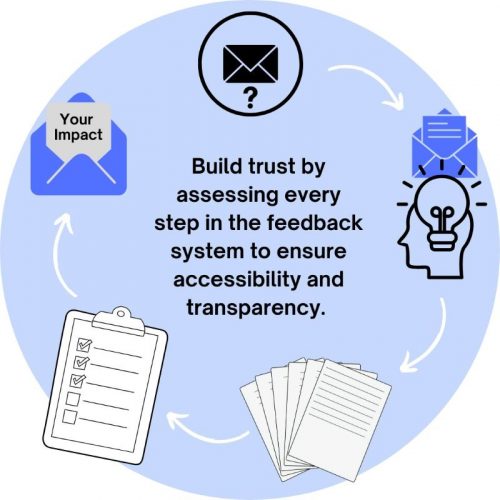Assessing Your Accessible Feedback Mechanisms
Organizations should assess their feedback systems to ensure that every step is accessible and supports the other points in the system and the success of the complete feedback loop. Each step carries its own challenges and opportunities for enhancing the entire feedback system.
Below are some considerations for each step to ensure accessibility for all team members.
1. How are you sending your message?
- What method are you using (oral, hand written, typed)?
- What delivery system are you using (email, in person, online, third party)?
- Are you using words and phrases that are in plain language and easily understood?
- Can your team members receive support to access the message?
2. How is your message being received?
- Is the context of your message understood by the audience?
- Do your team members have access to the necessary technology?
- Have you provided time/capacity for the team to respond?
- Have you confirmed with your team what their preferred method of communication is?

3. How are you receiving feedback?
- Have you given enough time for a response?
- What methods of response are you accepting (surveys, emails, feedback sessions, or other)?
- Are you receiving feedback anonymously?
- Have you confirmed that you understand the meaning and context of the feedback you’ve received?
4. How are you creating action?
- Are you taking action that’s free from retribution?
- Are your actions directly reflecting the required solutions?
- Are you being transparent about where and why action isn’t possible or can’t be completely fulfilled? Are you communicating that message?
- Do your actions also fulfil your accessibility and equity goals?
5. How are you communicating and demonstrating your actions?
- Is your messaging directed at the requesting group?
- Are you clearly illustrating how the feedback directly affected the action?
- Are you highlighting the link between the feedback and the accomplishments/changes?
- Is your message communicated in the same ways the feedback request was issued, received, and returned?
6. How are you building trust in the system?
- Are you supporting the needs of your team to participate fully in the feedback loop?
- Are you confirming that the feedback loop includes all team members in an equitable fashion?
- How are you ensuring your team members feel heard?
- Do your actions match your communication?
Each step in the feedback loop must be reviewed independently and then as a whole. If there are opportunities for improvement in any step of the system, corrections will bolster not only that step but the entire system.
The commitment to ensuring your feedback loops are accessible and actionable will ensure improved feedback going forward. If your teams feel they are considered andheard and that their suggestions are effective, the overall culture of the organization will improve—and that improvement will carry over into other measurable outcomes.

